
AI takes center stage, leaving little room for XR at one of the biggest startup expos in the region.
North Star Expand is part of the Gitex Global brand of events, with a specific focus on startups and innovation. This year featured air cars, robotics and other innovations, but by all accounts, AI completely overwhelmed every hall. Regardless of whether I was in the healthcare, blockchain, or finance part of the exhibition, most booths around me claimed they were either in AI or AI-inspired.
This left less room for virtual and augmented reality, but it still had a place as part of the “Immersive Tech” category, where a collage of various XR, Web3, AI and traditional gaming solutions would find their place. This ‘Immersive Tech’ label intersected with various regional mega-booths and industry-specific halls, so to fully understand how XR fits in the current startup ecosystem, one had to do a full tour. Here’s a quick rundown of the most interesting things that caught my eye.
The Exit Suit
In case you haven’t heard about Exit Suit, it’s a VR locomotion solution that can double as an experience simulator. The creator, Willy Winkler, calls it a ‘performance suit.’ The team won an Auggie Award in 2023 and came to Dubai with a new, improved model. The original prototype I saw at the AWE was made entirely from plywood. The upgraded version is made of steel (with leather cushioning), preserving its distinct spine-like look.
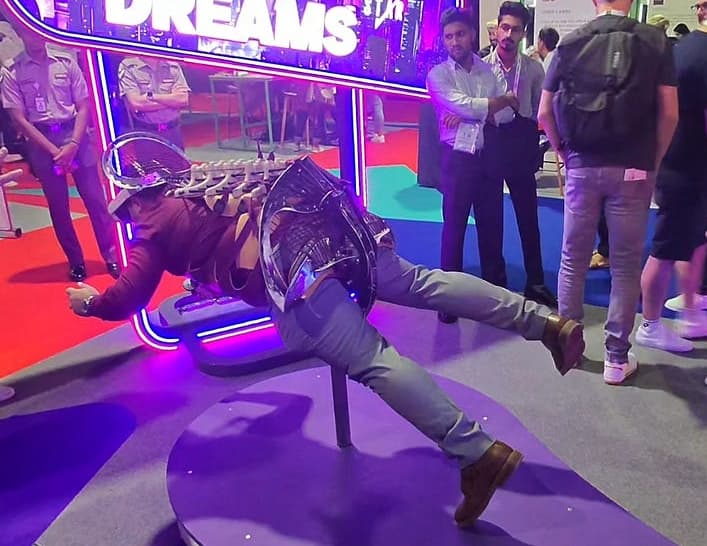
The Exit Suit provides full body support, suspending users slightly above the ground and allowing for both laying and upright postures. Initially, it was meant to include some form of resistance feedback, motion capture and an ability to run in the air, which would make it a complete locomotion device, but for now, the team has scaled back the plans and wants to focus on the Exit Suit’s strengths, which are the ability to feel like flying (or swimming), as well as the sensation of weightlessness.
Since locomoting is currently done with a controller, it would be interesting to see a proprietary demo developed, one that would play into the Exit Suits’ potencies. Without that, Exit Suit remains an unconventional engineering concept that requires investors to use their imagination—although I was told by the team that certain VR games like Population One work quite well with this setup.
It’s an early-stage prototype, so with adequate funding, it’s possible many shortcomings may be solved or alleviated. For now, there are issues regarding comfort and ease of use, and it’s definitely not a one-size-fits-all solution. Personally, I had fun trying it out and was happy to see the project continue to develop.
Skinetic Vest
In another hall, nestled between Metaverse and Blockchain pavillions, I found Actronica demoing its haptic vest Skinetic.
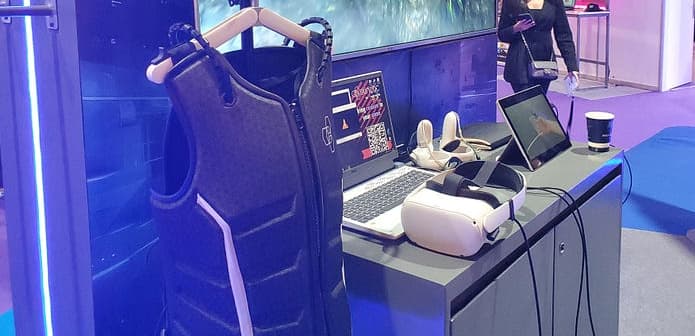
This was a pleasant surprise as I’ve never had a chance to try it out. The vest uses feedback actuators to simulate various sensations like touch, recoil or rumble. That’s different from what B*haptics is doing with vibro-tactile motors or Owo Suit with electrical pulses, but overall Skinetic can be considered to be in the same category.
I tried the vest first with Actronica’s proprietary VR demo and then with a popular VR game, “Pistol Whip.” Some aspects of the haptics were good: the vest was silent and easy to put on, and the feedback was responsive and high-frequency. However, other elements were lacking. For example, the intensity felt too mild, and the fabric wasn’t very breathable, making me feel hot after a while. The vest supports a couple of existing PCVR games via mods, and there’s also an option to convert audio to feedback, allowing the gear to be used with music, movies and non-VR games (similarly to how the Subpac vest works).
The proprietary demo felt particularly nice, standing in the rain gave me a realistic sensation similar to wearing a raincoat. Getting hit by virtual drones felt adequate. Playing Pistol Whip – a known VR game – felt less satisfactory, and the haptic felt much more generic.
The team is currently in the process of launching a Kickstarter campaign. The starting price will be around €399, which might not be competitive enough for the consumer market. Business and enterprise seem more likely venues, taking advantage of the vest via proprietary software and specific use cases.
Actronica also had an intriguing-looking “haptic cup” at their booth. When moved or shaken, the cup felt like it had liquid inside. It was a good example of how feedback actuators can be added to everyday objects, turning them into haptic devices. It’s an easy-to-deploy solution that I could see being useful in training, LBE or education.
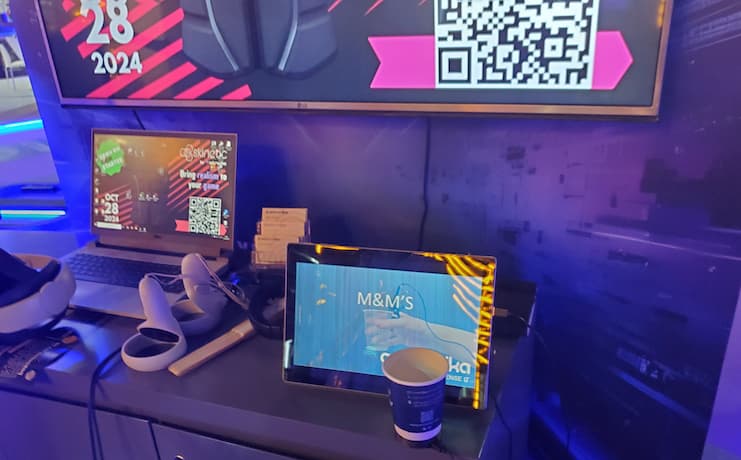
XR Startups Tackle Medical & Training
Headsets continue to be a valuable tool in helping entice visitors to stop, although gone are the days when startups used them ubiquitously. Nowadays, if a booth has an XR device, it’s usually for a reason. In Gartner’s terms, XR has entered the slope of enlightenment.

The two main categories of XR startups that I noticed were training and medical. Some companies were founded only recently, which is encouraging, but I found a lot of exhibitors at North Star Expand were four or five years old, which is a bit of a stretch if you call yourself a startup.
Most XR training booths offered end-to-end solutions, from designing software to deploying to supplying software and support. There’s also some crossover between training and education, so a decent number of companies offered such solutions as well. There’s no point in listing all, but Interact and Gritlabs made the biggest impression on me in terms of their portfolio and professionalism.
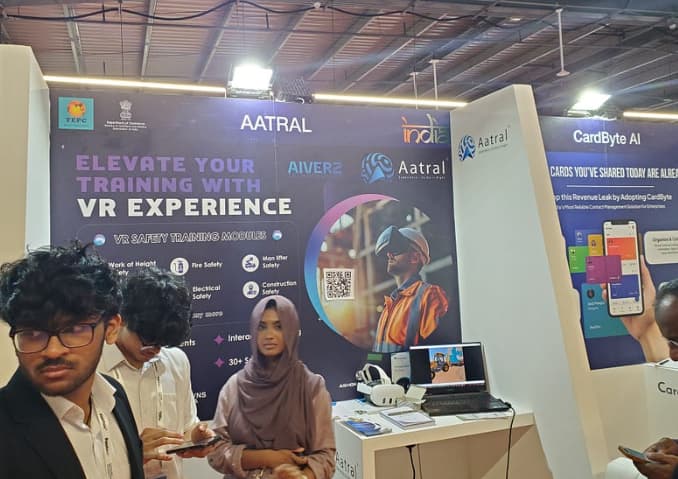
Medical-focused startups were usually more targeted in their offerings. For example, Novaid demonstrated AR solutions that improve emergency response, offering patient identification and guidance in stressful emergency circumstances. The company was founded in 2024 — an example of a fresh entrant into the XR space.
Other medical ventures include Holoeyes, a company that takes segmented CT and MRI scans and converts them into 3D models for head-mounted displays, or XRMedics, which provides therapy tools for the psychiatry and neurodivergence sectors.
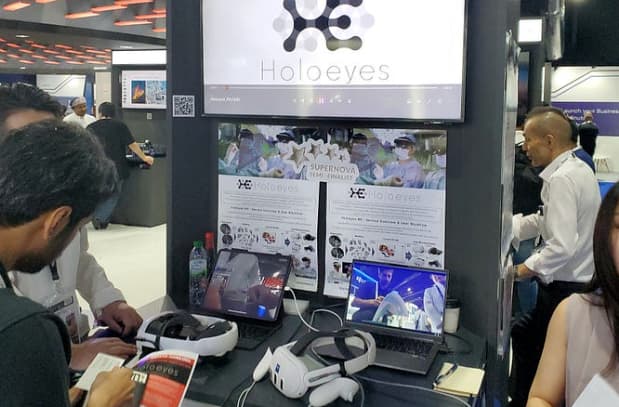
Finally, there’s the metaverse, although it seems to have morphed away from web3 and NFTs and more towards advertisements, brand recognition, personalized experiences and specific use cases like real estate walkthroughs, digital twins, etc. Out of all the metaverse companies I spoke to, only one mentioned NFTs (as part of their upcoming web3 game).
Interestingly, the game they were designing is not VR, but it does feature, as part of its branding, a WebXR component — most likely a promotional tool for trade shows designed to increase brand memory and brand recognition. It’s a small but practical example of how VR finds use by being applied strategically in specific scenarios.
Some companies leaned more toward avatar creation (CharacterXYZ), some towards AR/VR Marketing (Filter You), and some towards digital twins (Terraunity). The metaverse as a concept was still present, but its meaning remains hazy and all over the place.
State of XR and final thoughts
Gitex Global and North Star Expand are one of the biggest regional expos. In many ways, it’s humbling to see so many new innovators from all over the world experiment with XR. On the other hand, the buzz surrounding AI definitely impacted the overall visibility of immersive tech.
I was expecting to see more enterprise headsets on the show floor, like the Lenovo ThinkReality VRX or the Vive Focus 3, but it seems most startups opt for Quest 3, which might boil down to costs, ease of deployment, and other factors. I was also surprised by the lack of Apple Vision Pro. The Unity booth had one at their disposal, while another two were used to demonstrate a non-XR engineering project. That’s about it.
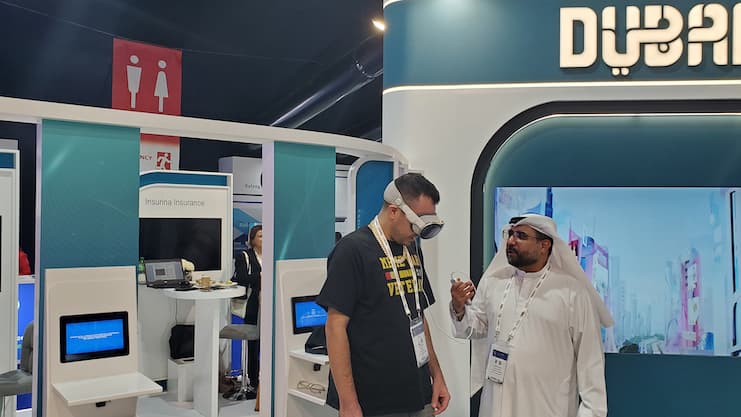
In a setting where air-car companies were aplenty and where robodogs from Boston Dynamics roamed freely, I would see the Apple Vision Pro as a natural fit and a good way to forward XR presence in general. In that sense, the Apple Vision Pro fell short of expectations.
 Mat Pawluczuk is an XR/VR writer and content creator. As with all AR Insider contributors, his opinions are his own.
Mat Pawluczuk is an XR/VR writer and content creator. As with all AR Insider contributors, his opinions are his own.

